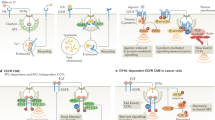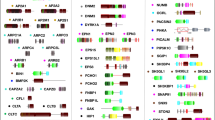Abstract
Endocytosis is a complex process fulfilling many cellular and developmental functions. Understanding how it is regulated and integrated with other cellular processes requires a comprehensive analysis of its molecular constituents and general design principles. Here, we developed a new strategy to phenotypically profile the human genome with respect to transferrin (TF) and epidermal growth factor (EGF) endocytosis by combining RNA interference, automated high-resolution confocal microscopy, quantitative multiparametric image analysis and high-performance computing. We identified several novel components of endocytic trafficking, including genes implicated in human diseases. We found that signalling pathways such as Wnt, integrin/cell adhesion, transforming growth factor (TGF)-β and Notch regulate the endocytic system, and identified new genes involved in cargo sorting to a subset of signalling endosomes. A systems analysis by Bayesian networks further showed that the number, size, concentration of cargo and intracellular position of endosomes are not determined randomly but are subject to specific regulation, thus uncovering novel properties of the endocytic system.
This is a preview of subscription content, access via your institution
Access options
Subscribe to this journal
Receive 51 print issues and online access
$199.00 per year
only $3.90 per issue
Buy this article
- Purchase on Springer Link
- Instant access to full article PDF
Prices may be subject to local taxes which are calculated during checkout





Similar content being viewed by others
Change history
11 March 2009
The b and c labels on Fig. 4 had been misplaced and were transposed on 11 March 2010.
References
Polo, S. & Di Fiore, P. P. Endocytosis conducts the cell signaling orchestra. Cell 124, 897–900 (2006)
Dudu, V., Pantazis, P. & González-Gaitán, M. Membrane traffic during embryonic development: epithelial formation, cell fate decisions and differentiation. Curr. Opin. Cell Biol. 16, 407–414 (2004)
Burgdorf, S. & Kurts, C. Endocytosis mechanisms and the cell biology of antigen presentation. Curr. Opin. Immunol. 20, 89–95 (2008)
Pagano, R. E., Puri, V., Dominguez, M. & Marks, D. L. Membrane traffic in sphingolipid storage diseases. Traffic 1, 807–815 (2000)
Gruenberg, J. & van der Goot, F. G. Mechanisms of pathogen entry through the endosomal compartments. Nature Rev. Mol. Cell Biol. 7, 495–504 (2006)
Baskys, A., Bayazitov, I., Zhu, E., Fang, L. & Wang, R. Rab-mediated endocytosis: linking neurodegeneration, neuroprotection, and synaptic plasticity? Ann. NY Acad. Sci. 1122, 313–329 (2007)
Marsh, M. & McMahon, H. T. The structural era of endocytosis. Science 285, 215–220 (1999)
Stenmark, H. Rab GTPases as coordinators of vesicle traffic. Nature Rev. Mol. Cell Biol. 10, 513–525 (2009)
Piper, R. C. & Katzmann, D. J. Biogenesis and function of multivesicular bodies. Annu. Rev. Cell Dev. Biol. 23, 519–547 (2007)
Perrimon, N. & Mathey-Prevot, B. Applications of high-throughput RNA interference screens to problems in cell and developmental biology. Genetics 175, 7–16 (2007)
Friedman, A. & Perrimon, N. A functional RNAi screen for regulators of receptor tyrosine kinase and ERK signalling. Nature 444, 230–234 (2006)
Rink, J., Ghigo, E., Kalaidzidis, Y. & Zerial, M. Rab conversion as a mechanism of progression from early to late endosomes. Cell 122, 735–749 (2005)
König, R. et al. A probability-based approach for the analysis of large-scale RNAi screens. Nature Methods 4, 847–849 (2007)
Kulkarni, M. M. et al. Evidence of off-target effects associated with long dsRNAs in Drosophila melanogaster cell-based assays. Nature Methods 3, 833–838 (2006)
Kittler, R. et al. Genome-wide resources of endoribonuclease-prepared short interfering RNAs for specific loss-of-function studies. Nature Methods 4, 337–344 (2007)
Birmingham, A. et al. 3′ UTR seed matches, but not overall identity, are associated with RNAi off-targets. Nature Methods 3, 199–204 (2006)
Cullen, B. R. Enhancing and confirming the specificity of RNAi experiments. Nature Methods 3, 677–681 (2006)
Echeverri, C. J. et al. Minimizing the risk of reporting false positives in large-scale RNAi screens. Nature Methods 3, 777–779 (2006)
Pelkmans, L. et al. Genome-wide analysis of human kinases in clathrin- and caveolae/raft-mediated endocytosis. Nature 436, 78–86 (2005)
Fukunaga, K. & Hostetler, L. The estimation of the gradient of a density function, with applications in pattern recognition. IEEE Trans. Inf. Theory 21, 32–40 (1975)
Hayakawa, A., Hayes, S., Leonard, D., Lambright, D. & Corvera, S. Evolutionarily conserved structural and functional roles of the FYVE domain. Biochem. Soc. Symp. 74, 95–105 (2007)
Habermann, B. The BAR-domain family of proteins: a case of bending and binding? EMBO Rep. 5, 250–255 (2004)
Carlton, J. G. & Martin-Serrano, J. Parallels between cytokinesis and retroviral budding: a role for the ESCRT machinery. Science 316, 1908–1912 (2007)
Hill, E., Clarke, M. & Barr, F. A. The Rab6-binding kinesin, Rab6-KIFL, is required for cytokinesis. EMBO J. 19, 5711–5719 (2000)
Baluska, F., Menzel, D. & Barlow, P. W. Cytokinesis in plant and animal cells: endosomes 'shut the door'. Dev. Biol. 294, 1–10 (2006)
Schnatwinkel, C. et al. The Rab5 effector Rabankyrin-5 regulates and coordinates different endocytic mechanisms. PLoS Biol. 2, e261 (2004)
Nielsen, E. et al. Rabenosyn-5, a novel Rab5 effector, is complexed with hVPS45 and recruited to endosomes through a FYVE finger domain. J. Cell Biol. 151, 601–612 (2000)
Galvez, T. et al. siRNA screen of the human signaling proteome identifies the PtdIns(3,4,5)P3-mTOR signaling pathway as a primary regulator of transferrin uptake. Genome Biol. 8, R142 (2007)
Sigismund, S. et al. Clathrin-independent endocytosis of ubiquitinated cargos. Proc. Natl Acad. Sci. USA 102, 2760–2765 (2005)
Motley, A., Bright, N. A., Seaman, M. N. & Robinson, M. S. Clathrin-mediated endocytosis in AP-2-depleted cells. J. Cell Biol. 162, 909–918 (2003)
Miaczynska, M. et al. APPL proteins link Rab5 to nuclear signal transduction via an endosomal compartment. Cell 116, 445–456 (2004)
Schenck, A. et al. The endosomal protein Appl1 mediates Akt substrate specificity and cell survival in vertebrate development. Cell 133, 486–497 (2008)
Pearl, J. Probabilistic Reasoning in Intelligent Systems: Networks of Plausible Inference (Morgan Kaufmann, 1988)
Petroski, M. D. & Deshaies, R. J. Function and regulation of cullin-RING ubiquitin ligases. Nature Rev. Mol. Cell Biol. 6, 9–20 (2005)
Miaczynska, M., Pelkmans, L. & Zerial, M. Not just a sink: endosomes in control of signal transduction. Curr. Opin. Cell Biol. 16, 400–406 (2004)
Kermorgant, S. & Parker, P. J. Receptor trafficking controls weak signal delivery: a strategy used by c-Met for STAT3 nuclear accumulation. J. Cell Biol. 182, 855–863 (2008)
Huang, S. S. & Huang, J. S. TGF-β control of cell proliferation. J. Cell. Biochem. 96, 447–462 (2005)
Le Borgne, R. Regulation of Notch signalling by endocytosis and endosomal sorting. Curr. Opin. Cell Biol. 18, 213–222 (2006)
Gagliardi, M., Piddini, E. & Vincent, J. P. Endocytosis: a positive or a negative influence on Wnt signalling? Traffic 9, 1–9 (2008)
Heldin, C. H., Landström, M. & Moustakas, A. Mechanism of TGF-β signaling to growth arrest, apoptosis, and epithelial-mesenchymal transition. Curr. Opin. Cell Biol. 21, 166–176 (2009)
Blank, U., Karlsson, G. & Karlsson, S. Signaling pathways governing stem-cell fate. Blood 111, 492–503 (2008)
Weinmaster, G. Notch signal transduction: a real rip and more. Curr. Opin. Genet. Dev. 10, 363–369 (2000)
Entchev, E. V. & González-Gaitán, M. A. Morphogen gradient formation and vesicular trafficking. Traffic 3, 98–109 (2002)
Santos, S. D., Verveer, P. J. & Bastiaens, P. I. Growth factor-induced MAPK network topology shapes Erk response determining PC-12 cell fate. Nature Cell Biol. 9, 324–330 (2007)
Acknowledgements
We acknowledge T. Galvez and G. Marsico, members of the Zerial group for discussions and scientific support. We are particularly indebted to K. Korn who developed transfection protocols and organized various preparatory steps and logistics before the screen and E. Krausz for the management of the HT-TDS, the MPI-CBG screening facility. We thank J. Schmitt, A. Lohmann, S. Christ, N. Tomschke, A. Niederlein, J. Wagner, M. Gierth, E. Krausz for technical, robotics and computational assistance, and M. Boes and J. Oegema for IT support that made the large-scale computational analysis possible. We acknowledge I. C. Baines, T. Galvez, J. Howard, T. Hyman, M. McShane, G. O’Sullivan and P. Tomancak for comments on the manuscript. This work was financially supported by the Max Planck Society (MPG) and by the systems biology network HepatoSys of the German Ministry for Education and Research BMBF, the DFG and the Gottlieb Daimler und Karl Benz Stiftung. This work is also part of the project ‘Endotrack’, which received research funding from the European Community’s Sixth Framework Programme.
Author Contributions C.C., Y.K. and M.Z. conceived the project and M.Z. directed it. C.C. and D.K. developed the endocytosis assay under the guidance of M.Z. and E.F.; M.S. performed the screen and image acquisition. Y.K. developed the QMPIA with the help of C.C. and J.C.R. and performed all computational analysis of the screening data. N.S. developed the clustering and pheno-score algorithms and together with C.C. performed the analysis of the clusters. C.R.B., under the supervision of B.H., performed the si/esiRNAs remapping and bioinformatics analysis. CC. and Y.K performed the Bayesian Network analysis. F.B. provided the esiRNA library. R.H., under the supervision of M.S.M. and W.E.N., provided IT support for the use of the computer cluster located at the TUD. C.C.,Y.K. and M.Z. wrote the manuscript.
Author information
Authors and Affiliations
Corresponding author
Ethics declarations
Competing interests
The authors declare no competing financial interests.
Supplementary information
Supplementary Information
This file contains Supplementary Materials and Methods with Supplementary Figures 11-12 with Legends, Supplementary Data and Supplementary References. (PDF 812 kb)
Supplementary Figures
This file contains Supplementary Figures 1-10 with Legends. (PDF 9116 kb)
Supplementary Table 1
This table contains a list of parameters used in the phenotype profiling. (XLS 30 kb)
Supplementary Table 2
This table contains a list of known genes involved in endocytic trafficking. (XLS 20 kb)
Supplementary Table 3
The table contains a list of kinases having an effect on VSV virus infection. (XLS 23 kb)
Supplementary Table 4
This table contains the 4609 genes that were considered for further analysis. (XLS 9732 kb)
Supplementary Table 5
This table includes the sequences of all si/esiRNAs targeting the 4609 positive genes. (XLS 5056 kb)
Rights and permissions
About this article
Cite this article
Collinet, C., Stöter, M., Bradshaw, C. et al. Systems survey of endocytosis by multiparametric image analysis. Nature 464, 243–249 (2010). https://doi.org/10.1038/nature08779
Received:
Accepted:
Published:
Issue Date:
DOI: https://doi.org/10.1038/nature08779
This article is cited by
-
Endocytic trafficking of GAS6–AXL complexes is associated with sustained AKT activation
Cellular and Molecular Life Sciences (2022)
-
Investigating receptor-mediated antibody transcytosis using blood–brain barrier organoid arrays
Fluids and Barriers of the CNS (2021)
-
Loss of COPZ1 induces NCOA4 mediated autophagy and ferroptosis in glioblastoma cell lines
Oncogene (2021)
-
Organoids in image-based phenotypic chemical screens
Experimental & Molecular Medicine (2021)
-
Multiplexed live-cell profiling with Raman probes
Nature Communications (2021)
Comments
By submitting a comment you agree to abide by our Terms and Community Guidelines. If you find something abusive or that does not comply with our terms or guidelines please flag it as inappropriate.



